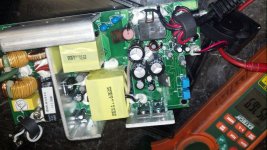e-beach
10 MW
bikeelectric said:].....Some of my cells do go a lot higher than the others and it is the ones that I had added and are not from the original batch. So until I get my new charger there will not be enough time for them to balance with the BMS, but with my current charger cutting from what I can tell it does not get high enough voltage to damage any of the high cells. I also tried putting large 10 ohm resistor in line with charger to lower current = which it did but charger still cuts off too early so that does me no good either.
OK, sounds like you are busy with work or life....but you will still need to determine a lot of different thing that are still a mystery to us on the other side of your posts, and post them so we know what they are
Your new charger might give you 58.4v but that is still no guarantee the cells will match in capacity even if your new charger works well with your old bms. Why would you want to lower the current of your charger?
We still need to know if your bms functions at 57.6v so do what dnmun has suggested to find that out.
We still need to know what your terminal cell voltages are after your charger turns off.
We still need to know what your cell voltages are after you left it on the charger over night.
We still need to know what your individual cell capacities are so you can build the bet pack possible with used cells.
We need you to post that info.
.



![ATTACH]](/sphere/proxy.php?image=http%3A%2F%2F%5BATTACH+type%3D%22full%22+alt%3D%22blown.jpg%22%5D165713._xfImport%5B%2FATTACH%5D&hash=5f899a58780872c53c69fe7894ebd41a)